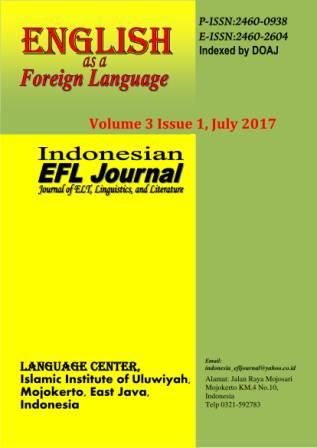ELT Research Papers as Authentic Materials in Teaching Research-Based Article Writing: A Case in Indonesian Context
Abstract
There are strong shreds of evidence that the choice of instructional materials has large effects on students’ achievement. This study was to assess the efficacy of using ELT research papers as authentic materials in teaching research-based article writing. This study was aimed at revealing whether or not there is a significant difference in students’ writing skill in terms of ELT research paper writing between the students who were taught by using ELT research papers as authentic materials and those who were taught by using textbook materials provided by the faculty. This study belongs to a quasi-experimental study with an experimental and control group pretest-posttest design. The population of this study was 75 students from the fourth semester of English Education Study Program of IKIP PGRI Bojonegoro, East Java, Indonesia. The sample was selected through cluster random sampling and consisted of 50 students that were divided into two groups. The instrument used to collect the data was a writing test. Consequently, normality and homogeneity of the data were tested. A t-test was used to compare the mean of the two groups. The hypothesis was designed and tested at 0.05 level of significance. The results revealed that there is a significant difference in students’ academic writing skill between the students who were taught by using the ELT research papers as authentic materials and those who were taught by using textbook materials. The t-test revealed that t-value is higher than t-table (6.07>2.01). Therefore it is concluded that the authentic instructional materials could significantly improve students’ academic writing skill.
References
Bailey, S. (2003). Academic writing: A handbook for international students. New York: Nelson Thornes Ltd.
Ditlitabmas Dirjen Dikti. (2014). Pedoman kreativitas mahasiswa. Jakarta: Ditlitabmas Dikti.
Firth, J.R., (1957). A synopsis of linguistic theory, 1930-55. In Palmer, F.R. (ed.) (1968). Selected papers of J.R. Firth 1952-59. London and Harlow: Longman.
Gardner, D., & Miller. (1999). Establishing self-access. Cambridge: Cambridge University Press.
Ghufron, M. A. (2015). Enhancing students’ academic writing skill by using research paper writing instructional materials. LENSA Journal, 5(2). 1 – 9. Retrieved from: http://jurnal.unimus.ac.id/index.php/lensa/article/view/1781
Hughes, A. (1996). Testing for language teachers. Cambridge: Cambridge University Press.
Maroko, Geoffrey M. (2010) The authentic materials approach in the teaching of functional writing in the classroom. In: Reinert, R. (ed.) (2010) The new decade and (2nd) FL Teaching: The initial phase Rudolf Reinelt Research Laboratory EU Matsuyama, Japan, p. 71 – 87
Masood, A. (2005). Exploiting authentic materials for developing writing skills at the secondary level: an experimental study. Journal for the study of English linguistics, 2013, 1(1) Pp. 21-71. Available at: http://dx.doi.org/10.5296/jsel.v1i1.4670
McDonough, J., & Shaw, C. (2004). Materials and Methods in ELT (2nd ed). Oxford: Blackwell.
New Jersey Education Department. (2015). New jersey registered holistic scoring rubric. Available at: http://gcit.enschool.org/ourpages/auto/2015/2/1/43163351/nj_registered_holistic_scoring_rubric.pdf.
Nunan, D. (2001). Second Language teaching and learning. Boston: Heinle and Heinle publishers.
Okobia, E.O. (2011). Availability and teachers’ use of instructional materials and resources in the implementation of social studies in junior secondary schools in Edo State, Nigeria. Review of European Studies, 3(2), 90-97. http://dx.doi.org/10.5539/res.v3n2p90
Oladejo, M.A., Olosunde, G.R., Ojebisi, A.O., & Isola, O.M. (2011). Instructional materials and students’ academic achievement in physics. Some Policy Implications. European Journal of Humanities and Social Sciences, 2(1), 112-126. Retrieved from: http://www.journalsbank.com/ejhss_2_4.pdf
Onasanya, S.A., & Omosewo, E.O. (2011). Effect of improvised and standard instructional materials on secondary school students’ academic performance in Physics in Ilorin, Nigeria. Singapore Journal of Scientific Research, 1(1), 68-76. http://dx.doi.org/10.3923/sjsres.2011.68.76
Oshima, A. & Hogue, A. (2006). Writing academic English: 4th edition. New York: Pearson Education, Inc.
Rahman, M. (2013). Using authentic materials in the writing classes: a tertiary level scenario. Master’s Thesis: BRAC University
Richards, J. C. (2005). Materials development and research-making the connection. Paper Presented at a Colloquium on Research and Materials Development, at the TESOL Convention, San Antonio.
Richards, J.C. & Renandya, W.A. (2002). Methodology in language teaching: an anthology of current practice. Cambridge: Cambridge University Press.
Tamo. (2009). The use of authentic materials in the classroom. Linguistics and communicative performance journal, 2(1).
Whitaker, A. (2009). A step-by-step guide to writing academic papers. Bratislava: City University of Seattle.
Copyright (c) 2017 Indonesian EFL Journal: Journal of ELT, Linguistics, and Literature

This work is licensed under a Creative Commons Attribution-ShareAlike 4.0 International License.
All rights reserved.
this publication may be reproduced, stored in a retrieval system, or transmitted
in any form or by any means, electronic, mechanical, photocopying, recording.




